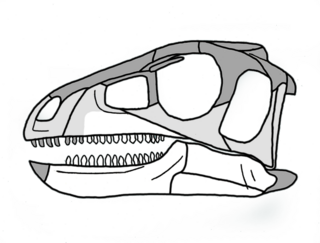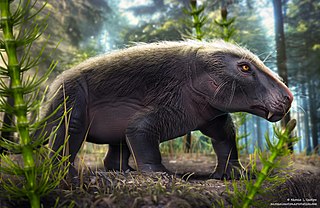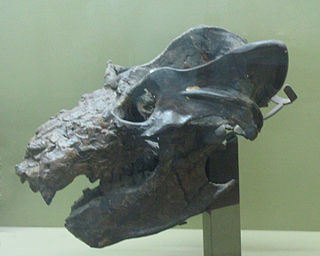
Eoraptor is a genus of small, lightly built, basal sauropodomorph dinosaur. One of the earliest-known dinosaurs and one of the earliest members of the sauropod family, it lived approximately 231 to 228 million years ago, during the Late Triassic in Western Gondwana, in the region that is now northwestern Argentina. The type and only species, Eoraptor lunensis, was first described in 1993, and is known from an almost complete and well-preserved skeleton and several fragmentary ones. Eoraptor had multiple tooth shapes, which suggests that it was omnivorous. Eoraptor was 1.5 feet tall and 3 feet long.
Eucoelophysis is a genus of silesaurid dinosauriform from the Late Triassic (Norian) period Chinle Formation of New Mexico. It was assumed to be a coelophysid upon description, but a study by Nesbitt et al. found that it was actually a close relative of Silesaurus, which was independently supported by Ezcurra (2006), who found it to be the sister group to Dinosauria, and Silesaurus as the next most basal taxon.

Azendohsaurus is an extinct genus of herbivorous archosauromorph reptile from roughly the late Middle to early Late Triassic Period of Morocco and Madagascar. The type species, Azendohsaurus laaroussii, was described and named by Jean-Michel Dutuit in 1972 based on partial jaw fragments and some teeth from Morocco. A second species from Madagascar, A. madagaskarensis, was first described in 2010 by John J. Flynn and colleagues from a multitude of specimens representing almost the entire skeleton. The generic name "Azendoh lizard" is for the village of Azendoh, a local village near where it was first discovered in the Atlas Mountains. It was a bulky quadruped that unlike other early archosauromorphs had a relatively short tail and robust limbs that were held in an odd mix of sprawled hind limbs and raised forelimbs. It had a long neck and a proportionately small head with remarkably sauropod-like jaws and teeth.

Revueltosaurus is an extinct genus of suchian pseudosuchian from Late Triassic deposits of New Mexico, Arizona and North Carolina, United States. Many specimens, mostly teeth, have been assigned to Revueltosaurus over the years. Currently, three species are included in this genus, all of which were originally thought to represent monospecific genera of basal ornithischian dinosaurs. It was 1 meter long.
Technosaurus is an extinct genus of Late Triassic silesaurid dinosauriform, from the Late Triassic Cooper Canyon Formation of Texas, United States.
Krzyzanowskisaurus is the name given to a genus of archosaur from the Late Triassic-aged Chinle Formation and it is a tooth taxon, based on fossils only of teeth and these teeth have been found in the U.S. states of Arizona and New Mexico. The original report described it as a "probable ornithischian" and Heckert (2005) suggests that Krzyzanowskisaurus teeth have biostratigraphic utility as an index fossil of the St. Johnsian sub-LVF.

Pisanosaurus is an extinct genus of early dinosauriform, likely an ornithischian or silesaurid, from the Late Triassic of Argentina. It was a small, lightly built, ground-dwelling herbivore, that could grow up to an estimated 1 m (3.3 ft) long. Only one species, the type, Pisanosaurus mertii, is known, based on a single partial skeleton discovered in the Ischigualasto Formation of the Ischigualasto-Villa Unión Basin in northwestern Argentina. This part of the formation has been dated to the late Carnian, approximately 229 million years ago.
Lucianosaurus is an extinct genus of amniote of unknown affinities, known only from teeth. Initially described as a basal ornithischian dinosaur, subsequently reclassified as a member of the clade Archosauriformes of uncertain phylogenetic placement and later, taking into account the similarity of its teeth to the teeth of traversodontid cynodonts such as Dadadon, as an amniote of uncertain affinities.

Massetognathus is an extinct genus of plant-eating traversodontid cynodonts. They lived during the Triassic Period about 235 million years ago, and are known from the Chañares Formation in Argentina and the Santa Maria Formation in Brazil.

Dinosauromorpha is a clade of avemetatarsalian archosaurs that includes the Dinosauria (dinosaurs) and some of their close relatives. It was originally defined to include dinosauriforms and lagerpetids, with later formulations specifically excluding pterosaurs from the group. Birds are the only dinosauromorphs which survive to the present day.

Traversodontidae is an extinct family of herbivorous cynodonts. Traversodonts were primarily Gondwanan, with many species known from Africa and South America. Recently, traversodonts have also been found from Europe and North America. Traversodonts first appeared in the Middle Triassic and diversified in the Late Triassic before going extinct at the end of the epoch. The family Traversodontidae was erected by Friedrich von Huene in 1936 for cynodonts first found in São Pedro do Sul in Paleorrota, Brazil.

Heterodontosauridae is a family of ornithischian dinosaurs that were likely among the most basal (primitive) members of the group. Their phylogenetic placement is uncertain but they are most commonly found to be primitive, outside of the group Genasauria. Although their fossils are relatively rare and their group small in numbers, they have been found on all continents except Australia and Antarctica, with a range spanning the Early Jurassic to the Early Cretaceous.

Exaeretodon is an extinct genus of fairly large, low-slung traversodontid cynodonts from the southern parts of Pangea. Four species are known, from various formations. E. argentinus is from the Carnian-age Cancha de Bochas Member of the Ischigualasto Formation in the Ischigualasto-Villa Unión Basin in northwestern Argentina. E. major and E. riograndensis are from the Carnian-age portion of the Santa Maria Formation of the Paraná Basin in southeastern Brazil. E. statisticae is from the Carnian-age Lower Maleri Formation of India.
The Tecovas Formation is a geological formation in the Texas panhandle and eastern New Mexico. It is one of several formations encompassed by the Late Triassic Dockum Group.

Silesauridae is an extinct family of Triassic dinosauriforms. It is most commonly considered to be a clade of non-dinosaur dinosauriforms, and the sister group of dinosaurs. Some studies have instead suggested that most or all silesaurids comprised an early diverging clade or a paraphyletic grade within ornithischian dinosaurs. Silesaurids have a consistent general body plan, with a fairly long neck and legs and possibly quadrupedal habits, but most silesaurids are heavily fragmentary nonetheless. Furthermore, they occupied a variety of ecological niches, with early silesaurids being carnivorous and later taxa having adaptations for specialized herbivory. As indicated by the contents of referred coprolites, Silesaurus may have been insectivorous, feeding selectively on small beetles and other arthropods.

Diodorus is a genus of silesaurid dinosauromorph that lived during the Late Triassic in what is now Morocco. Fossils were discovered in the Timezgadiouine Formation of the Argana Basin, and were used to name the new genus and species Diodorus scytobrachion. The genus name honors the mythological king Diodorus and the ancient historian Diodorus Siculus; the specific name is ancient Greek for 'leathery arm' and also honors the mythographer Dionysius Scytobrachion. The holotype specimen is a partial dentary bone (front of the lower jaw), and assigned specimens include isolated teeth, two humeri (upper arm bones), a metatarsal (foot bone), and femur (thigh bone).

Gomphodontosuchinae is a subfamily of Triassic traversodontid cynodonts. It includes the genera Gomphodontosuchus, Exaeretodon, Santagnathus, Siriusgnathus, Menadon, Proexaeretodon,Protuberum, Ruberodon and Scalenodontoides.

Massetognathinae is an extinct subfamily of cynodonts in the family Traversodontidae. It includes four species from the Middle and Late Triassic: Massetognathus pascuali from Argentina, Massetognathus ochagaviae and Santacruzodon hopsoni from southern Brazil, and Dadadon isaloi from Madagascar. Massetognathines have several distinguishing characteristics, including flattened skulls, small canine teeth, and postcanine teeth with three cusps on their outer edges. Massetgognathinae was defined by Kammerer et al. (2012) as the clade containing all traversodontids more closely related to Massetognathus pascuali than to Gomphodontosuchus brasiliensis, and is the sister taxon of the traversodontid subfamily Gomphodontosuchinae, which was defined by Kammerer et al. (2008) as all traverodontids more closely related to G. brasiliensis than to M. pascuali.

Laquintasaura is a genus of Venezuelan ornithischian dinosaur containing only the type species Laquintasaura venezuelae. The species was the first dinosaur to have been identified from Venezuela. It is known from extensive remains, all from a singular bonebed locality which has been sampled for specimen blocks over the course of several expeditions, largely led by Marcelo R Sánchez-Villagra. A small, very primitive animal, it is known for its distinct dental anatomy and for being one of the earliest and most primitive ornithischians in the fossil record. Taxonomic uncertainty has led to conflicting theories that it is either as the base of Ornithischia or at the base of the subgroup Thyreophora. In either model, its dating to around 200 million years ago, at the start of the Jurassic, existence in equatorial latitudes, and primitive nature make it a key view into early ornithischian evolution. It's thought that Laquintasaura would've lived in groups and had a possible omnivorous diet, living on a seasonal alluvial plain and being preyed about by the contemporary Tachiraptor.

Buriolestes is a genus of early sauropodomorph dinosaurs from the Late Triassic Santa Maria Formation of the Paraná Basin in southern Brazil. It contains a single species, B. schultzi, named in 2016. The type specimen was found alongside a specimen of the lagerpetid dinosauromorph Ixalerpeton.














